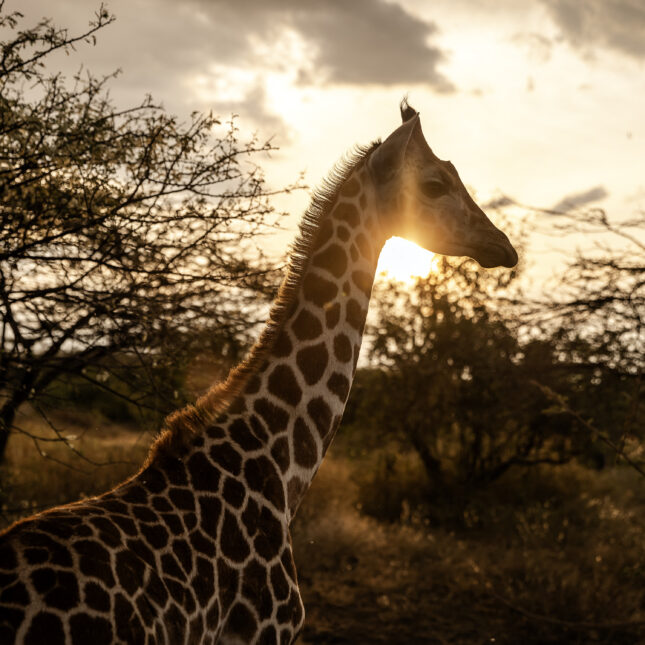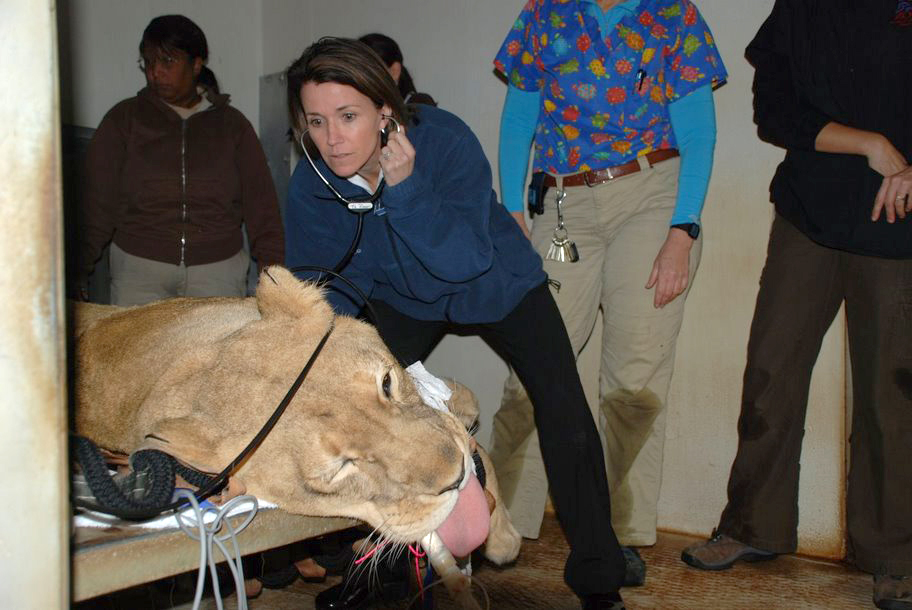
For much of Barbara Natterson-Horowitz’s career, her work has revolved around one idea: The field of human medicine has suffered from being too human-centered. Natterson-Horowitz is a cardiologist, psychiatrist, and evolutionary biologist who co-authored the 2012 book “Zoobiquity: The Astonishing Connection Between Human and Animal Health.”
When people think about the link between human and animal health, what often comes to mind are zoonotic diseases, preventing the next pandemic, or antimicrobial resistance on farms, Natterson-Horowitz said. They don’t usually think of all the diseases we have in common, like how horses can get melanoma or how killer whales can develop Hodgkin’s lymphoma. Or that dolphins can get genital herpes and koalas can get chlamydia.
Zoobiquity focuses on medical issues like heart disease, cancer, and infertility, as well as psychiatric and behavioral diseases that humans and millions of animal species experience alike. Natterson-Horowitz argues that by viewing health through an evolutionary lens, we can better understand the causes of diseases and accelerate the discovery of new treatments.
“What if we started to think about animals that may have evolved physiologies that solve some problems that our human physiologies haven’t solved?” Natterson-Horowitz said. “[Evolution] is R&D on the highest dose of steroids ever.”
Natterson-Horowitz is a professor of cardiology at UCLA, and teaches human evolutionary biology and global health and social medicine at Harvard. She spoke with STAT’s Nicholas St. Fleur in June at Aspen Ideas: Health about how we can leverage animal health experts to solve human medical problems. Here are edited excerpts from that panel discussion and a subsequent interview in July.
Tell me about yourself and your work.
I’m a cardiologist and an evolutionary biologist, and I spent the first 20 years of my career as a professor of medicine in cardiology. But for the last 10 years, I’ve been studying the connections between human and animal health. And I’ve become convinced that answers for maybe all of the most vexing human health challenges that we have can be found in the natural world, particularly across the animal kingdom. What I do is innovate strategies to find those answers and transform them into solutions, which we can then bring back to the human bedside. After all, humans are animals.

What was that moment that flipped the switch for you, where you realized as a physician that you should look into the animal kingdom as well?
In about 2005, the Los Angeles Zoo had some great apes who had cardiovascular issues, and they wanted a human cardiologist to come and work alongside the veterinarians. Occasionally I’d get a call to go to the zoo for a chimpanzee with heart failure or a gorilla who they were concerned had a torn aorta.
I graduated beyond great apes to bears and lions. We had a lion who had a collection of fluid in her pericardial sac. It’s called a cardiac tamponade. It’s a diagnosis that is not uncommon when you’re working in a busy urban hospital. But in a lion, it was incredible to see. And what I began to see was that there were many, many conditions that I really had never even thought about whether other species were vulnerable to these diseases too … Over the course of years, I saw so many commonalities. I learned so much from veterinarians, and I was humbled in a way that I would have thought impossible about how little I knew as a physician and how much I could learn.
Are there any specific stories from your work with animal health where you were just thinking to yourself, “Why hasn’t anyone applied this to humans?”
One has to do with maternal health. Breastfeeding. The American Academy of Pediatrics recommends two years of breastfeeding, but fewer than 20% of American women can do a year. A lot of them stop because of a painful infection in the breast called mastitis.
So I turned to the dairy industry and to a couple of dairy veterinarians. It turns out there are about a hundred years worth of research on preventing mastitis in dairy animals. They have a noninvasive, startlingly inexpensive approach to preventing it. I went on rounds with this dairy vet in central California. They take a wooden paddle and there are four Petri dishes on it. As the milking process is happening, they take a few drops of milk and put it in the dish.
That test has like a 90% sensitivity for detecting what’s called subclinical mastitis. In other words, the cow doesn’t even have symptoms; there are just some inflammatory white cells in the milk. Guess how much it costs? There’s a one time upfront cost of the paddle, $5 to $15. And each test is $0.10 to $0.25. They have an intervention which is equally noninvasive … If they find that there’s subclinical mastitis, they just change the milking schedule.
So the question is why on Earth hasn’t this been brought into human medicine?

Why on Earth hasn’t it?
Human exceptionalism! It is a scientific blindfold. It prevents us from recognizing connections. And I think it’s the tendency to think, “Oh, we’re humans, those are cows.” Instead of, “We’re both mammals.” The biology of lactation is highly conserved across all mammalian species. We look at differences. We don’t look at commonality. And as a result, we miss so much.
I want to know exactly what the human version of that knowledge is and give it to lactation consultants, pediatricians, and OB-GYNs. There have been a hundred times more scientific studies written about preventing mastitis in cows than in women. It’s very activating because of how absurd that is.
What else do you think we’re missing because of this blindfold of human exceptionalism?
Where it is a thick blindfold is when it comes to mental health. There is still this idea that psychiatric disorders are a human problem and not an animal problem. I think we all know now if we have dogs and animals in our home, that is not the case.
If you think about biodiversity not just as beautiful colored animals in the rainforest, but as neurodiversity across the animal kingdom, then any animal that has a brain or a central nervous system of any kind, including invertebrates, including insects — if it can be healthy, it can be unhealthy. Across species we see anxiety. Across vertebrates we see depression. Depression has an evolutionary purpose. It evolved about 450 million years ago in social fish, and there’s a huge amount we can learn about that.
What does applying a zoobiquity lens to medicine look like?
A zoobiquitous approach, if I can call it that, is to look at a human medical problem that has been really tough to solve and then ask the question, “Is there a non-human animal whose physiology might have already solved that problem? Has evolution produced a solution?” Then there’s a whole process of how you identify what that species might be. Then it’s looking at their genome and looking at how that resistant physiology occurs. CRISPR [genome editing], I think, is one of what will be many technologies to ideally — once you’ve found the species that has the solution — find ways to modify the human phenotype to confer that kind of protection or resistance to whatever the disease is.
What’s an example of this?
I’m a heart doctor and I’m a woman. One of the biggest focuses of the National Institutes of Health right now is a condition called HFpEF [heart failure with preserved ejection fraction], which is a leading cause of heart failure in women. People who have high blood pressure often develop HFpEF where the heart gets very stiff with fibrosis. So we thought, can we turn to the animal world to find any solution to HFpEF? We turned to the giraffe.
Why the giraffe?
The hypothesis is there’s something special about the giraffe’s heart that’s allowing it to be exposed to a high blood pressure of 280/180 — normal for us is 120/80. Giraffes somehow have evolved the ability to not develop this form of heart failure, even though their blood pressures are so much higher than ours. So what is that adaptation? What is that solution?
We have the genome of the giraffe and we can compare it to its closest relative that doesn’t have a long neck, the okapi. The long neck of the giraffe is what gives it the high blood pressure. They shared an ancestor about 11.5 million years ago. We can identify specifically what’s unique about the giraffe’s heart from a genomic perspective. A group led by Chang Liu in 2021 in Science Advances, when they compared these two genomes, they found that there were a number of differences between the giraffe and the okapi. One of them was the FGFRL1 gene that’s involved with high blood pressure and hearts.
They took a group of mice and they CRISPRed this giraffe FGFRL1 into the mice. They had two populations, the wildtype mice which just had normal mouse FGFRL1, and then they had these mice that had giraffe FGFRL1. They exposed both mice populations to something called angiotensin II, which really raises the blood pressure. The mice that had the giraffe FGFRL1, they didn’t get the fibrosis. But, as you would expect, the wildtype had lots and lots of fibrosis.
What this says to us is maybe there’s a way for us to leverage this adaptation that took 11.5 million years of evolution, and bring giraffe FGFRL1 to the bedside for my human patients. Many people are working on this.
What other animals should we be looking at to potentially solve problems in human health?
There are a whole bunch of animals that have some degree of cancer resistance, like bowhead whales, some bats, and of course, the classic elephant story. African elephants have multiple copies of this cancer suppressing gene called TP53. And some research has shown that their lymphocytes are particularly good at stopping abnormal cell division. So it appears that elephants have some cancer resistance.
Any last thoughts to share about zoobiquity or human exceptionalism in medicine?
There’s human exceptionalism where we think that our species is superior to other species. We are not uniquely unique and we’re not superior. But then there’s this professional piece of it. I think one of the barriers is a lack of humility on the part of physicians and medical institutions that have agency to recognize the value of these insights from the veterinary world and the value that can be brought over to the human side. What have we learned from 20 years of the comparative genomics revolution? We have learned that there are differences, yes, but there’s a hell of a lot of commonality. And our human exceptionalism is so deeply embedded that I think we vastly underestimate the value of those animal insights for primary care, cardiovascular care, cancer care, even psychiatric care of humans.






